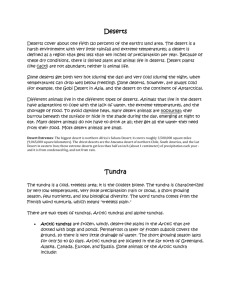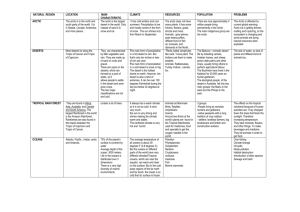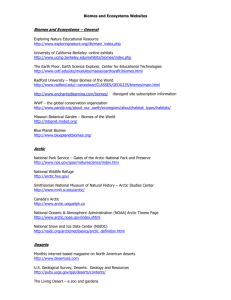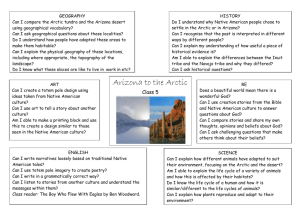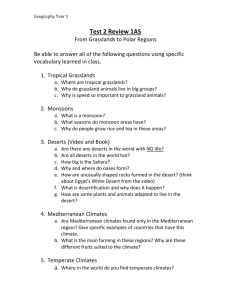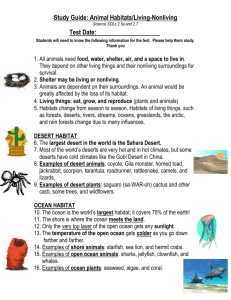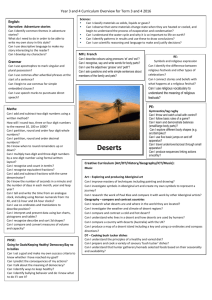Arctic Animals
advertisement
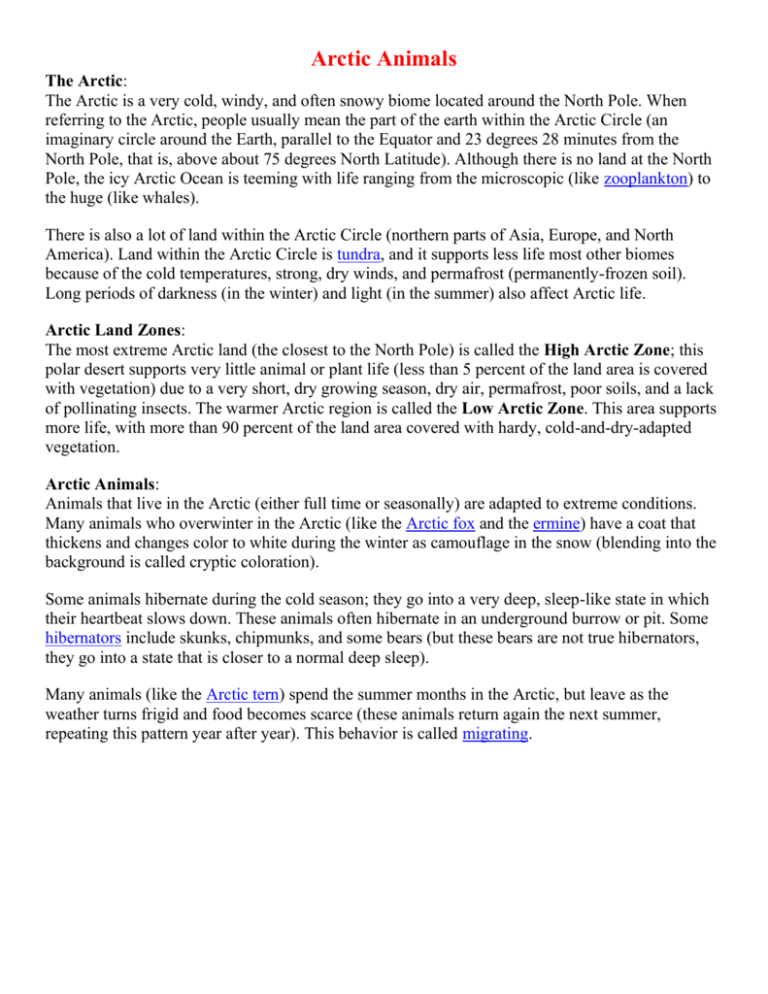
Arctic Animals The Arctic: The Arctic is a very cold, windy, and often snowy biome located around the North Pole. When referring to the Arctic, people usually mean the part of the earth within the Arctic Circle (an imaginary circle around the Earth, parallel to the Equator and 23 degrees 28 minutes from the North Pole, that is, above about 75 degrees North Latitude). Although there is no land at the North Pole, the icy Arctic Ocean is teeming with life ranging from the microscopic (like zooplankton) to the huge (like whales). There is also a lot of land within the Arctic Circle (northern parts of Asia, Europe, and North America). Land within the Arctic Circle is tundra, and it supports less life most other biomes because of the cold temperatures, strong, dry winds, and permafrost (permanently-frozen soil). Long periods of darkness (in the winter) and light (in the summer) also affect Arctic life. Arctic Land Zones: The most extreme Arctic land (the closest to the North Pole) is called the High Arctic Zone; this polar desert supports very little animal or plant life (less than 5 percent of the land area is covered with vegetation) due to a very short, dry growing season, dry air, permafrost, poor soils, and a lack of pollinating insects. The warmer Arctic region is called the Low Arctic Zone. This area supports more life, with more than 90 percent of the land area covered with hardy, cold-and-dry-adapted vegetation. Arctic Animals: Animals that live in the Arctic (either full time or seasonally) are adapted to extreme conditions. Many animals who overwinter in the Arctic (like the Arctic fox and the ermine) have a coat that thickens and changes color to white during the winter as camouflage in the snow (blending into the background is called cryptic coloration). Some animals hibernate during the cold season; they go into a very deep, sleep-like state in which their heartbeat slows down. These animals often hibernate in an underground burrow or pit. Some hibernators include skunks, chipmunks, and some bears (but these bears are not true hibernators, they go into a state that is closer to a normal deep sleep). Many animals (like the Arctic tern) spend the summer months in the Arctic, but leave as the weather turns frigid and food becomes scarce (these animals return again the next summer, repeating this pattern year after year). This behavior is called migrating. Desert Habitats Deserts cover about one fifth (20 percent) of the earth's land area. The desert is a harsh environment with very little rainfall and extreme temperatures; a desert is defined as a region that gets less than ten inches of precipitation per year. Because of these dry conditions, there is limited plant and animal life in deserts. Desert plants (like cacti) are not abundant; neither is animal life. Some deserts get both very hot (during the day) and very cold (during the night, when temperatures can drop well below freezing). Some deserts, however, are always cold (for example, the Gobi Desert in Asia, and the desert on the continent of Antarctica). Different animals live in the different types of deserts. Animals that live in the desert have adaptations to cope with the lack of water, the extreme temperatures, and the shortage of food. To avoid daytime heat, many desert animals are nocturnal; they burrow beneath the surface or hide in the shade during the day, emerging at night to eat. Many desert animals do not have to drink at all; they get all the water they need from their food. Most desert animals are small. Desert Extremes: The biggest desert is northern Africa's Sahara Desert; it covers roughly 3,500,000 square miles (9,065,000 square kilometers). The driest deserts are the Atacama desert of northern Chile, South America, and the Lut Desert in eastern Iran; these extreme deserts get less than half an inch (about 1 centimeter) of precipitation each year - and it is from condensed fog, and not from rain. Some of the largest deserts in the world: Name of Deserts Location Animals Great Sandy Desert, Great Victoria, Simpson, Australia bilby, dingo, kangaroo, marsupial mole, quokka, rabbit-eared bandicoot, etc. Gibson, Tanami Arabian Desert Arabian Peninsula dromedary, dung beetle, camel, civet, Egyptian vulture, flamingo, fox, gazelle, hare, hedgehog, Arabian horse, hyena, ibex, jackal, jerboa, lesser bustard, lizard, locust, oryx, peregrine falcon, porcupine, sand cobra, scorpion, skink, veiled chameleon, viper, etc. Chihuahuan Mexico/S.W. USA big free-tailed bat, coyote, diamondback rattlesnake, kangaroo rat, roadrunner, vampire bat, etc. Kalahari S.W. Africa gazelle, gerbil, ground squirrel, hyena, jackal, meerkat, springbok, etc. Mojave S.W. USA bighorn sheep, coyote, desert tortoise, jack rabbit, pupfish, sidewinder, etc. Monte Argentina, South America armadillo, cavy, jaguarundi, puma,tinamou, tuco-tuco, etc. North Africa addax antelope, barn owls, cape hare, dama deer, desert hedgehog, dorcas gazelle, fan-tailed raven, Fennec fox, gerbil, horned viper, jackal, jerboa, mouse, Nubian bustard, ostrich, sand fox, shrew, slender mongoose, spiny-tailed lizard, spotted hyena, etc. Sonoran S.W. USA, Mexico barn owl, big free-tailed bat, black widow spider, bobcat, chuckwallas, coati, collared peccary, desert iguana, desert tortoise, dragonfly, elf owl, gila monster, kangaroo rat, pack rat, Mexican gray wolf, mule deer, pupfish, rattlesnake, redtailed hawk, roadrunner, scorpion, sidewinder, tarantula, turkey vulture, wild burros, etc. Thar Indian, Pakistan dromedary, great Indian bustard, Indian spiny-tailed lizard, jackal, sandgrouse, etc. Atacama Peru, Chile llama, Peruvian fox, etc. Gobi China, Mongolia Bactrian camel, beetles, blue hill pigeon, desert wheatear, gazelle, gecko, Mongolian gerbil, jerboa, Gobi bear, jerboa, lizards, onager, Pallas cat, Pallas sandgrouse, Przewalski horse, short-toed larks, snow leopard, wild mountain sheep, wolf, etc. Iranian Iran, Afghanistan, and Pakistan monitor lizard, onager, oryx, scorpion, etc. Namib S. W. Africa fringe-toed lizard, golden mole, jackal, sidewinder, viper, web-footed gecko, etc. Sahara Grasslands and Grasslands Animals What is a Grassland? A grassland is a grassy, windy, partly-dry biome, a sea of grass. Almost one-fourth of the Earth's land area is grassland. In many areas, grasslands separate forests from deserts. Deep-rooted grasses dominate the flora in a grassland; there are very few trees and shrubs in a grassland, less than one tree per acre. There are many different words for grassland environments around the world, including savannas, pampas, campos, plains, steppes, prairies and veldts. There are two types of grasslands, including: Tropical grassland - hot all year with wet seasons that bring torrential rains. Located between the Tropic of Cancer and the Tropic of Capricorn, sometimes called savannas. Temperate grasslands - hot summers and cold winters. The evaporation rate is high, so little rain makes it into the rich soil. Located north of the Tropic of Cancer and south of the Tropic of Capricorn. Animal Adaptations: The animals that live in grasslands have adapted to dry, windy conditions. There are grazing animals (that eat the grass), burrowing animals, and their predators; insects are abundant. A moderate of level species diversity exists on a grassland. Where are Grasslands? Grasslands are located in North America's interior (called prairies), in southeastern South America (Argentina's pampas and the campos of Uruguay and Brazil), in Eurasia (the Eurasian steppe in Mongolia and parts of the former Soviet Union), in Africa (the semi-arid steppes of the Sahel of north-central Africa and the wetter grasslands, veldts, of East Africa and Madagascar), and in Australia and New Zealand (called rangelands). Animals that Live in Grasslands: Many animals live in grasslands, from invertebrates (like grasshoppers and beetles) to large mammals (like antelopes and bison). The different grasslands of the world support different populations of animals. Africa - aardvark, African wild cat, African elephant, many antelopes, baboon, buffalo, Cape hunting dog, cheetah, giraffe, gnu, hartebeest, hippopotamus, hyena, impala, jackals, kudu, leopard, lion, meerkat, mongoose, oryx, ostrich, red-billed oxpecker, rhinoceros, vulture, wildebeest, zebra, and many other animals. Australia - dingo, emu, kangaroo, wallaby, wombat, and many other animals. Many non-native animals have been introduced, including the camel, donkey, goat, horse, rabbit, and sheep. North America - American toad, badger, black-footed ferret, bison, black-tailed jack rabbit, bumble bee, burrowing owl, California condor, carrion beetle, common snipe, coyote, deer, dragonfly, eagles, eastern cottontail, elk, ferruginous hawk, fox snake, golden owl, gopher snake, grasshopper, gray wolf, ground squirrels, killdeer, lady beetle, larks, long-billled curlew, meadow vole, monarch butterfly, northern grasshopper mouse, prairie chicken, prairie dog, prairie rattlesnake, prairie skink, pronghorn antelope, red fox, red-tailed hawk, shrew, skunk, stink bug, tiger beetle, western meadowlark, western tiger swallowtail, white-tailed jack rabbit, and many other animals. South America - armadillo, opossum, fox, jaguar, llama, puma, rhea, tapir, many rodents, and many other animals. Eurasia - golden pheasant, leopard gecko, snow leopard, vole, and many other animals. A Sampling of Tropical Rainforest Animals Rainforests are very dense, warm, wet forests. They are havens for millions of plants and animals. Rainforests are extremely important in the ecology of the Earth. The plants of the rainforest generate much of the Earth's oxygen. These plants are also very important to people in other ways; many are used in new drugs that fight disease and illness. Where are Rainforests? Tropical rainforests are located in a band around the equator, mostly in the area between the Tropic of Cancer (23.5° N latitude) and the Tropic of Capricorn (23.5° S latitude). This 3,000 mile (4800 km) wide band is called the "tropics." Tropical rainforests are found in South America, West Africa, Australia, southern India, and Southeast Asia. Go to a rainforest map printout to color. Strata of the Rainforest Different animals and plants live in different parts of the rainforest. Scientists divide the rainforest into strata (zones) based on the living environment. Starting at the top, the strata are: EMERGENTS: Giant trees that are much higher than the average canopy height. It houses many birds and insects. CANOPY: The upper parts of the trees. This leafy environment is full of life in a tropical rainforest and includes: insects, birds, reptiles, mammals, and more. UNDERSTORY: A dark, cool environment under the leaves but over the ground. FOREST FLOOR: Teeming with animal life, especially insects. The largest animals in the rainforest generally live here. Animals that Live in Rainforests: Ridiculously huge numbers of animals live in rainforests, including microscopic animals, invertebrates (like insects and worms), fish, reptiles, amphibians, birds, and mammals. The different rainforests of the world support different populations of animals. A few animals from each rainforest are listed below: South America o insects (morpho butterfly, Julia butterfly, Monarch butterfly, and millions of other insects) o mammals (jaguar, ocelot, didelphid opossums, sloth, howler monkey, spider monkey, capybara, many bats, marmosets, procyonids, peccaries) o birds (quetzal, macaw, tinamous, curassows, hoatzins, hummingbirds, eagles, ovenbirds, antbirds, flycatchers, puffbirds, toucans, jacamars, tanagers, tapirs, troupials, honeycreepers, cardinal grosbeaks, xenops) o reptiles (anaconda, caiman, iguanas, lizards, microteiid lizards, boas, and coral snakes), amphibians (poison arrow frog, etc.) o fish (electric eel, piranha), and millions of other animals. Australia o mammals (tree kangaroo, rat kangaroo, yellow-footed Antechinus, Giant White-tailed Uromys, opossums, bandicoot, echidna, duck-billed platypus, sugar glider, red legged pademelon) o birds (cassowary, brolga, emerald dove, orange-footed scrubfowl, Australian brushturkey, sarus crane, gray goshawk, wompoo fruit dove, topknot pigeon, Australian king parrot, laughing kookaburra, lesser sooty owl, fernwren, barred cuckoo-shrike, golden whistler, etc.) o reptiles (frilled lizard, carpet python, Green Tree Snake, Spotted Tree Monitor, Eastern Water Dragon, Boyd's Forest Dragon, Northern Leaf Tailed Gecko) o insects (Ulysses butterfly, Zodiac Moth, Union Jack butterfly, Regent skipper, Birdwing Butterfly) o amphibians (Giant Tree frog, Striped marsh frog, Northern Barred frog, Dainty Green Tree frog), and millions of other animals. Southeast Asia o mammals (tarsiers, orangutans, Siamangs, gibbons, colobine monkeys, tigers, tree shrews, binturong, moonrats, most flying foxes, colugos, bamboo rats, Oriental dormice) o birds (tree swifts, leafbirds, fairy bluebirds, fantails, whistlers, flowerpeckers, wood swallows) o insects (Queen Alexandra's Birdwing butterfly, Goliath Birdwing butterfly, Saturn Butterfly), and millions of other animals. West Africa o mammals (antelopes, bonobo, chimpanzee, gorilla, Mandrill, scaly-tailed squirrels, otter shrews, duikers, okapi, hippopotamus, Cercopithecus monkeys, bushbabies, pygmy hippo, duiker) Temperate Deciduous Forest Animal Printouts Temperate deciduous forests are forests in cool, rainy areas; they have trees that lose their leaves in Fall and regrow them in Spring. Temperate deciduous forests are found in the middle latitudes around the globe and have four distinct seasons: Spring, Summer, Fall, and Winter. In the Northern Hemisphere, these forests are found in North America, Europe, and Asia. In the Southern Hemisphere, there are smaller areas of these forests, in South America, Africa, and Australia. The growing season in these forests is about 6 months long. Temperature and Precipitation: The average temperature in temperate deciduous forests is roughly 75°F (24°C) but gets as high as 86°F (30°C), depending on the altitude of the forest. Forests higher in the mountains are colder. Deciduous forests receive from 2 to 5 feet (0.5-1.5 m) of precipitation (both rain and snow) each year. Humidity in these forests is high, from 60% to 80%. Fall Colors: In the Fall, the number of hours of daylight decreases. This causes some plants and trees (called deciduous) to stop producing chlorophyll (a green pigment that converts sunlight into chemical energy) and eventually lose their leaves. During this time, these leaves turn brilliant colors, ranging from red to orange to yellow to brown. Soil: The soil in the deciduous forests is quite fertile, since it is often enriched with falling leaves, twigs, logs, and dead organisms. Layers of the Temperate Deciduous Forest: There are five layers (also called zones or strata) in the temperate deciduous forest. These include the: Tree stratum, the tallest layer, 60 -100 feet high, with large oak, maple, beech, chestnut, hickory, elm, basswood, linden, walnut, or sweet gum trees. Small tree or sapling layer - short tree species and young trees. Shrub layer - shrubs like rhododendrons, azaleas, mountain laurels, and huckleberries. Herb layer - short plants. Ground layer - lichens, clubmosses, and true mosses. Some Animals Found in Temperate Deciduous Forests: Ant Bald Eagle Beaver Ants are The bald eagle is a large bird of The beaver is a large rodent social insects. prey. It is the symbol of the that builds dams and dens. USA. Black Bear A large, black to brown bear. Brown Bear Collared Peccary Deer The Brown Bear is a large A pig-like mammal, also Cardinal The deer is a bear with a muscular known as the javelina, from The cardinal is a hump on its shoulders. brilliant red bird with deserts, chaparrals and forests shy, fast-moving plant-eater. a short, wide bill. of North and Central America. Earthworm Fox Frog An earthworm is a little animal The fox is a meat-eating Tadpoles grow with a long, soft body and no The dhole is a wild mammal with a long, bushy up to be frogs. legs. dog from Asia. tail. Dhole Mallard Duck The Mallard is a common wild duck that is the ancestor of most domestic ducks. Muskrat Muskrats are rodents Newts are small, that often build brightly-colored dome-shaped salamanders. houses. Opossum The Virginia opossum is the only marsupial in North America. Over 64 species of opossum are found in South America. Newt Nightingale A small songird that sings beautiful, complex songs, often at night. Rabbit A fastRaccoon moving The raccoon is a mammal Porcupines are mammal with with mask-like markings mammals with long ears. on its face and a ringed tail. protective, needle-like quills on their body. Porcupine Scorpion Red Fox Red-Tailed Hawk The Red Fox is a The Red-Tailed Hawk is a meat-eating mammal bird of prey, a raptor from with a long, bushy tail. North America. Skunk A venomous Skunks are black and arachnid with a large stinger on its white mammals that can produce a terrible odor. tail. Weasel Squirrel Turkey Squirrels are rodents. They Turkeys are large live in a variety of biomes, birds that nest on the including the taiga. ground. A carnivorous mammal that has a long, slender body and short legs. White-Tailed Deer The white-tailed deer is a shy, fast-moving plant-eater.
